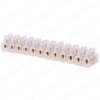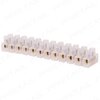I'm maybe old fashioned and maybe over cautious. I don't think you can beat copper conductors in very close contact with each other and well clamped - so all of the current is passed through copper, for lowest resistance with the purpose of the jointing system just there to maintain that close intimate connection.
For what it's worth, I'm equally old-fashioned, and it's far from unusual to see me mentioning slight personal nervousness about spring-based connections.
However, there is no doubt that they are increasing in popularity and those who wish to allay my 'nervousness' remind me that the technology has been around (at least to some extent) for decades, that it compensates for movement/creep in the copper over time (particularly if thermally-cycled) and, perhaps most of relevant of all, that it does not depend on the (always 'uncertain') human element of the tightening of the screw in a screwed connection.
The main 'weakness of 'our' view is presumably that it is totally reliant on "copper conductors [being]in very close contact with each other and well clamped". If it could be shown that alternatives to screwed terminals could more reliably achieve that initially and/or more reliably maintain that situation in the long-term, then a fair bit of our argument could go out of the window.
Besides which, choc blocks are much cheaper/ more available

That can't be denied, at least at present.
As for the 'size' issue, as I've said, I'm not so sure about that now that we have 221 series Wagos (and also 'in-line' ones, such as I illustrated). That could become increasingly important if one was faced with the (in my opinion 'silly') arguments about 'current ratings' of connector blocks - if, in a situation such as the OP's, one felt compelled to use a connector block rated at 30/32A, they are quite large!
Kind Regards, John




